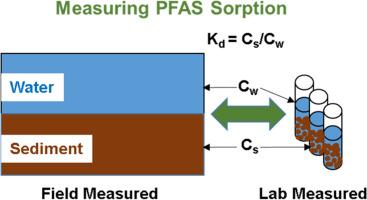Field versus laboratory measurements of PFAS sorption by soils and sediments
IF 5.4
Q2 ENGINEERING, ENVIRONMENTAL
引用次数: 0
Abstract
Sorption by soils and sediments is an important process that influences the distribution, transport, and fate of per and polyfluoroalkyl substances (PFAS) in the environment. Many laboratory studies have been conducted to quantify magnitudes of PFAS sorption as a function of the properties of the PFAS, solutions, and porous media. A critical question is how representative are laboratory-measured sorption magnitudes for field applications. To address this question, log Koc data were compiled from the literature for a range of PFAS of different chain lengths and functional groups. The aggregated field-based data consisted of two types, in-situ measurements comprising paired soil/sediment and water samples and ex-situ measurements obtained from laboratory desorption experiments employing field-contaminated media. These two sets of field-based measurements were compared to a comprehensive data set of standard laboratory batch-type measurements. The compiled data sets represent an extremely wide range of soil and sediment properties. One important novel outcome is the observation that the enhanced sorption of short-chain PFAS observed in several prior laboratory studies is also observed for the field data. This differential enhanced sorption should be accounted for in site investigations and modeling studies. Another relevant outcome is the observation of consistency between measurements obtained with standard batch adsorption experiments and those from desorption studies employing either field-contaminated or artificially-contaminated media. The mean log Koc values determined for the in-situ measured field data were generally larger than the mean laboratory-determined values, particularly for the short-chain PFAS. Notably, however, values for subsets of the laboratory data representing measurements for lower aqueous concentrations or for soils with low organic-carbon contents (<1 %) compared well to the in-situ field data. Measurements compiled for anionic-polyfluoroalkyl, neutral, and cationic PFAS compared well to those for PFCAs and PFSAs. Overall, the results indicate that the laboratory measurements of PFAS sorption were generally representative of the field-derived magnitudes when compared on a consistent basis.

土壤和沉积物对全氟辛烷磺酸吸附性的实地测量与实验室测量
土壤和沉积物的吸附作用是影响全氟烷基和多氟烷基物质(PFAS)在环境中的分布、迁移和归宿的重要过程。许多实验室研究都是为了量化全氟辛烷磺酸吸附量与全氟辛烷磺酸、溶液和多孔介质特性的函数关系。一个关键问题是,实验室测量的吸附量在实地应用中有多大的代表性。为了解决这个问题,我们从文献中整理出了一系列不同链长和官能团的 PFAS 的对数 Koc 数据。汇总的现场数据包括两类:由成对的土壤/沉积物和水样本组成的现场测量数据,以及利用现场污染介质进行实验室解吸实验获得的现场测量数据。这两组实地测量数据与标准实验室批量测量的综合数据集进行了比较。汇编的数据集代表了极其广泛的土壤和沉积物特性。一个重要的新成果是,在之前的几项实验室研究中观察到的短链全氟辛烷磺酸吸附增强现象在实地数据中也得到了观察。在现场调查和建模研究中应考虑到这种差异化的增强吸附力。另一个相关结果是观察到标准批量吸附实验所获得的测量值与采用现场污染或人工污染介质进行解吸研究获得的测量值之间存在一致性。现场原位测量数据确定的平均对数 Koc 值通常大于实验室确定的平均值,尤其是短链全氟辛烷磺酸。不过,值得注意的是,实验室数据子集的数值代表了对较低水溶液浓度或有机碳含量较低的土壤(1%)的测量值,与现场原位数据的比较结果良好。针对阴离子-聚氟烃基、中性和阳离子全氟辛烷磺酸的测量结果与针对全氟砷化物和全氟辛烷磺酸的测量结果进行了很好的比较。总体而言,结果表明,当进行一致比较时,实验室对全氟辛烷磺酸吸附性的测量值一般都能代表现场得出的数值。
本文章由计算机程序翻译,如有差异,请以英文原文为准。
求助全文
约1分钟内获得全文
求助全文
来源期刊

Journal of hazardous materials advances
Environmental Engineering
CiteScore
4.80
自引率
0.00%
发文量
0
审稿时长
50 days
 求助内容:
求助内容: 应助结果提醒方式:
应助结果提醒方式:


